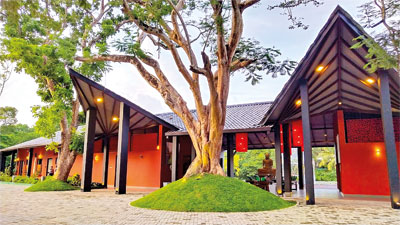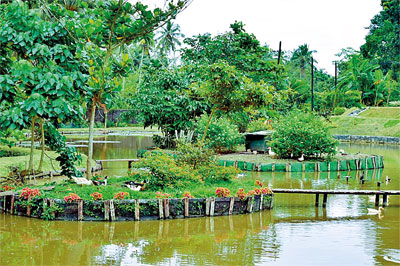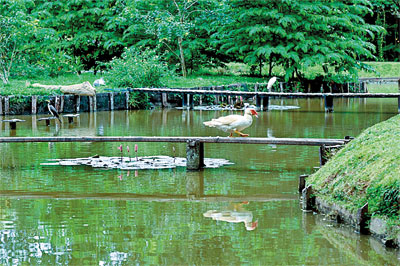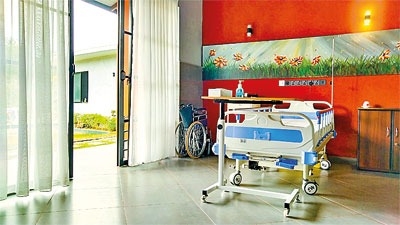News
An oasis for terminally ill patients and their kith and kin too

Dr. Chrysantha Perera
Tranquillity and serenity descend like a gentle and soothing veil on anyone who walks or is wheeled in along its manicured pathways, past ponds dotted with water lilies and lotuses, into simply but aesthetically furnished lodgings.Set in green and lush surroundings, balm to weary eyes, it is a haven not only for those who take up lodging here but also their family members.
Unimaginable it is that this is Ward 65, opened just last year and the latest to be added to the Karapitiya Teaching Hospital in Galle, with no other precursor in a state or private hospital. It is also believed to be one of its kind in South Asia.
It is the ‘Sath Sith – Sath Kam Palliative Care Centre’, a dire need in Sri Lanka, the brainchild of Senior Oncological Surgeon, Dr. Chrysantha Perera.
“We want to give a decent and comfortable life for those who are stricken by a terminal illness and also an honourable and dignified death,” says Dr. Perera, reiterating that it is a holistic and multidisciplinary effort.
This Palliative Care Centre brings into its fold the close kith and kin of the patient too, teaching them how to look after that person at home.
Usually, the person who is suffering from a terminal illness is kept at the Palliative Care Centre to control the symptoms of the illness, while looking into his/her physical, mental, social and spiritual well-being.
The Sunday Times understands that ‘palliative or supportive care’ is the care and support for people with a life-limiting illness (also life-threatening or terminal) and their family and friends. It does not include prolonging or shortening life but facilitates a good quality of life for the patient. A life-limiting illness cannot be cured and the person is likely to die from it. Such illness gets worse over time and includes advanced cancer, incurable heart and lung diseases, advanced tuberculosis (TB) neurological diseases such as paralysis etc., and dementia.
Palliative care includes managing physical symptoms such as pain; emotional, spiritual and psychological support; social care including help with things like washing, dressing or eating; and support for family and friends.
Opened on March 18, last year, Dr. Perera yearned to set up this Palliative Care Centre after looking after his beloved mother who was afflicted by many non-communicable diseases (NCDs) including cancer, hypertension, ischaemic heart disease, glaucoma and dementia. She passed away three years ago, with Dr. Perera making her life comfortable at a paid nursing home under 24-hour care.
But, he asks, how many people can afford to pay for such care, while also looking at the reality of a rapidly-ageing population and families struggling to eke out a living, which may not have the time or the money to care for their elderly. Into this scenario also comes increased life expectancy as well as rising numbers of those affected by cancer and other incurable illnesses.
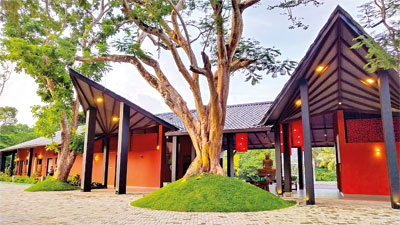
‘Sath Sith – Sath Kam Palliative Care Centre’ opened last year in March
Taking a reality-check, he points out that Sri Lanka, unlike countries such as Australia and Japan, does not have a proper fabric of social services which people can have as a safety net.
With regard to palliative care, he says that earlier the concept was that such care would begin once the full armament of medical treatment was exhausted and there was no other option for the patient or the family. That thinking has changed and now both medical treatment and palliative care go hand-in-hand from Day 1 of a terminal illness is diagnosed.
…….And so was born the Karapitiya Palliative Care Centre with all facilities such as TV, radio, soothing piped music and bathrooms with fittings for the disabled as well as hot and cold water, which can accommodate 30 patients. There are 10 individual rooms and 20 beds in two dormitories. All for free, without a cent being charged from the patient.
Set up to care for those in the south, Dr. Perera says that there is no barrier for people from other areas seeking refuge here. Anyone can seek registration at the Palliative Care Clinic which functions every Saturday from 8 a.m. to 12 noon at the Karapitiya Hospital’s Oncology Unit’s OPD with dedicated Medical Officers (MOs) of the Onco-Surgical Ward in attendance in collaboration with the Palliative Care Team including volunteer nurses. His full including volunteers and two permanent nursing officers attached to the clinic are very self-motivated.
He stresses that ‘Open Access’ is the clinic where no referral is needed by a patient.
Looking back, he says that the seeds of this beautiful tree which now shelters and gives refuge to those needing palliative care were planted with a fund-raising programme initiated in collaboration with the Sri Lanka Cancer Society (Galle Branch) on May 29, 2019 with a 10-month deadline. Nearly Rs. 73 million was collected, with contributions large and small from the public and Rs. 20m from the President’s Fund. The very first donation of Rs. 1m had been from a retired Principal, Mr. Somadasa, of Ambalangoda who has so far contributed Rs. 5.3m.
Soon construction began with the Sri Lanka Navy volunteering to give of its manpower and technical support, working tirelessly to make the Palliative Care Centre what it is, giving form to the drawings of architect Anura de Silva for whom too it was a labour of love.
Dr. Perera says that simultaneously nurses and doctors received local and international training in palliative care.
Appreciative of the fact that the basic resources, infrastructure and utilities such as electricity and water, human resources, medicines, equipment and other supplies are provided by the government through the Health Ministry, he adds that food and beverages, some expensive drugs and equipment are provided by well-wishers and donors.
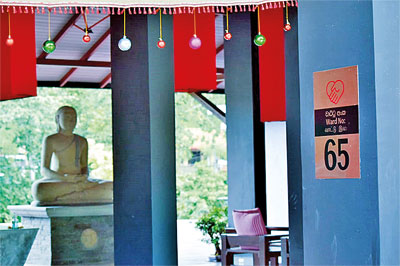 This is while a volunteer team with the support of the Sri Lanka Cancer Society (Galle Branch) works with enthusiasm and energy to provide optimal care with sub-groups comprising volunteer nursing officers taking the lead role with the help of MOs from different disciplines, looking into all aspects such as pain management,wound/stoma care, nutrition, counselling, functional status support, spiritual/psychological and social services. When these patients need in-ward care, they are transferred to the Onco-Surgical Ward.
This is while a volunteer team with the support of the Sri Lanka Cancer Society (Galle Branch) works with enthusiasm and energy to provide optimal care with sub-groups comprising volunteer nursing officers taking the lead role with the help of MOs from different disciplines, looking into all aspects such as pain management,wound/stoma care, nutrition, counselling, functional status support, spiritual/psychological and social services. When these patients need in-ward care, they are transferred to the Onco-Surgical Ward.
Underscoring that this is a journey he has embarked on with the unstinting commitment of many, Dr. Perera who is the Head of the Palliative Care Team says he is heavily supported by his surgical team, MOs, 14 palliative care nurses, two pain management nurses, wound/stoma care management nurses, psychiatric and counselling team, spiritual care team, nutrition team and social worker.
He pays strong tribute to all the Physicians and other Consultant Doctors of the Karapitya Teaching Hospital for their cooperation, with particular mention of the pain management team consisting of Consultant Anaesthetists Dr.Gihan Piyasiri and Dr. Janaka Ranaweera and two pain management nurses.
As they look to the future, the hope is to achieve excellence in palliative care by upgrading this centre to a National Palliative Care Training Centre.
Truly, when looking at the ‘Sath Sith – Sath Kam Palliative Care Centre’, one can say that when pain and anguish wring the brow, ministering angel thou!
